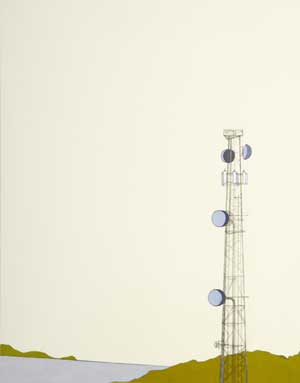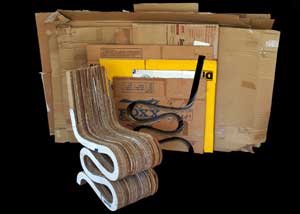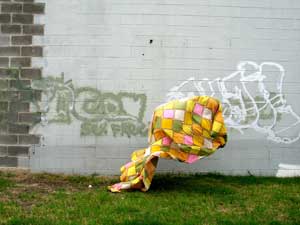A noticeable shift in this year’s New American Talent (NAT) exhibition,
at Arthouse in Austin through August, is the curator’s exacting
attention to photography. Digital technology is increasing the amount
of photography being created and presented today.
While photography is intermittently included in survey exhibitions, NAT would suggest that the kids are now being allowed to sit at the grown-ups’ (i.e., the painters’) table. Although the photography in NAT often feels like an afterthought, curator Anne Ellegood of the Hirshhorn Museum and Sculpture Garden in Washington, D.C., has made a bold move in bringing the medium front and center. The overall quality of the photographic works from the 850 applicants is surprising, given that many photographers are reluctant to apply to this annual juried exhibition due to its exclusion of this medium in past years.
The major weakness of NAT is the presentation of too many subsections, resulting in the feeling of a clump of work here, a clump of work there. This is true of theme (race and alienation), medium (ink, found materials and works on paper) and style (juxtaposition, overlay and sparseness). The unifying factor is the very lack of resonance — not one part jumps out or tends to be all that exciting.
NAT artists ask more questions than they provide answers to the exhibition’s question of what is new. To paraphrase choreographer Martha Graham, You can’t make up work, you have to discover it. But it seems as if many of the artists are mimicking one another’s styles rather then forging new ground. (This may simply reflect a national trend as more and more artists are graduating from MFA programs.) What you get here is fewer tour de force, whizbang pieces and more of a slow burn. While the former can sometimes be too much sugar, not enough substance, there are several exceptions.
Dave Woody’s large, meditative photographic portraits are a rare treat. Their power lies in their simplicity: you carry away only what is present. With so much recent attention garnered by European photographers like Rineke Dijkstra and Thomas Ruff, the portrait is hard to make fresh. But Woody conveys a newness through a reduced color palette and the positioning of his subject, thus encouraging us to look full on. Allison Wermager’s BEEEEP, a sound installation of found answering machines, is perfectly done. Most of the messages are trivial and inconsequential, lacking any real interpersonal connection, although at times a more emotional message surfaces. Wermager serves up these vestiges of late technology in a huge jumbled pile, where distorted voices, power cords, and telephone wires have been preserved in a bizarre chasm of posterity. Roberto Bellini’s video work Landscape Theory captures the artist at work attempting to tape a horde of black grackles gathering at sunset. An older man approaches off-camera and warns Bellini at garrulous length that he can’t tape the birds: “People are on edge. Looks like you’re videotaping that overpass. The police have been making arrests for things like that.” The whole interaction is heard as a voiceover to other sunset images. Normally difficult to pull off, Bellini’s post-9/11 discourse speaks brilliantly to our collective loss of innocence and public space.

Rebecca Rothfus...Untitled (highway one)...2006...Gouache, pencil and paper on panel...14 x 11 inches
The setup to Damien Gilley’s Parking Lot Miracle video piece starts off predictably –– a man walks across a deserted parking lot, sees a boombox on the ground, then continues on. Seconds later he returns to look around, and realizing he is alone, he presses play and begins to dance. The payoff to this short video is a memorable section halfway through: As the dancer is in the middle of a midair barrel turn, Gilley suspends the tape and jogs the frame back and forth a number of times, mimicking the break-beat scratching of a cheesy Casio keyboard loop. The gravity-defying choreography is charming and humorous and fresh even upon multiple viewings. Equally engaging is Elizabeth Axtman’s video American Classic, which effectively moves the race discussion forward in a cunning, yet direct manner. Framed by her hair, Axtman faces the camera directly and lip-syncs lines lifted from old movies about racial passing. Although we see her underlying torment, Axtman could also break out laughing at any moment as the joke is on the viewer, or at least on those viewers with bigoted perceptions. There are several other strong race-based works present, including Sonseree Verdise Gibson’s Let’s Discuss the Word “Nigger” and Brad Farwell’s An African Mask Looks at Sites of American Blackness: New Orleans Superdome.
Several works of note for their material investigation include William Hundley’s photographs of suspended fabrics; Jonathon Durham’s Foreskin, composed of tobacco, oil clay and a remote control helicopter; Suzanne Wright’s large-scale colorful drawing “Rainbow Highway” (G.W.B.); Wonjung Choi’s delightful mixed-media installation evoking a kindred spirit to the fish imagery of Lee Bontecou; and Ansen Seale’s crafted screenprint Oil for Food, with its purposeful substitution of the artist’s blood for ink.
Relational works in NAT abound: Jenene Nagy’s topologically themed sculptures; Joseph Phillips’ works on paper; Miguel-Angel Avila and Michael Cambre’s use of collaged imagery; the sparse nature of both Jennifer Nelson and Wura-Natasha Ogunji’s works on paper; Felice Grodin and Elwyn Palmerton’s migrating Mylar ink drawings; and the organized line qualities of work by Tom Mueske and Kirk Stoller.
On first view, NAT seemed exciting in its new commitment to photography, but subsequent viewing revealed an overall palette that felt gray, both in tone and vision. But this is the current state of the union, is it not?
Images courtesy Arthouse
Andrew Long is an artist and writer currently living in Austin.









2 comments
I think you missed a subtle technical feature of Damien Gilley’s Parking Lot Miracle video. While the dancer is being choreographed by manipulating the video flow (start, stop, reverse, forward, repeat, and that kind of thing), the cars in the background continue to move normally, without interference from the video editing. See it on youtube here: http://youtube.com/watch?v=HpWx0_7hv00
sounds boring.